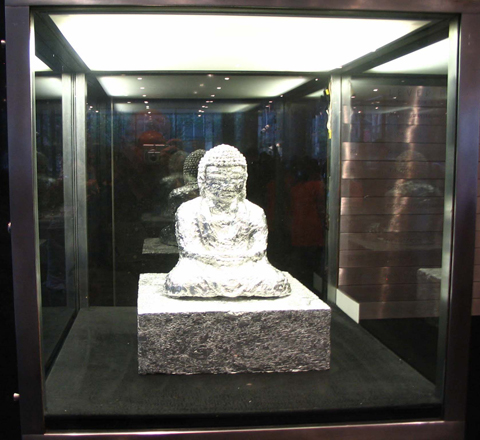February 2009
I
The infant, unaided, learns the metaphysics of experience before anything. The movement of time. The chains of causality. Power and efficacy. The singularity of personhood. These insights are there, in the cradle and stroller, as early and formative as the psycho-social experiences of mom, dad, brother and sister. But aside from just being power-knowledge, the infant also rightly understands these principles as limitations… I cannot unbreak that bottle… I cannot be my father… I’m unable to pass through walls. The Reality Principle deals heavily in metaphysical strictures as well, and unsurprisingly, these strictures and limitations then give rise to metaphysical fantasies of overcoming, fantasies which, in themselves, can help us to understand those ordering principles.
Within Hollywood mythos and pop-culture, metaphysical fantasies often translate into blockbusters that rival the popularity of the psycho-social fantasies of love, status, and feel-goodness. Examine the deep metaphysical release you feel during Groundhog’s Day, or Back to the Future, or even Time Bandits.. The weird dream-elation with the mix-and-match subjectivity of Being John Malkovich. The reversed causality of Memento. The suspension of Kantian categories which are, we can surmise, still regulatory. Demanding. Keeping us in check… Silently endured but resented.
Hollywood and other bits of mythos demonstrate that, though the Kantian categories condition the perceived metaphysic of real experience, we can still visualize their violation. Create a plausible, sensible, flipside metaphysic of Martian experience. In so doing, we get the surge and tingle of wish-fulfillment, but also a better understanding of our ordering-principles themselves. These organizing principles, though in a sense a priori, can no longer be thought of, as Kant did, as “absolutely independent of all experience.” By extension, analogy, and techne, we can dismantle their absoluteness, necessity, and universality.. We can see them as a contingent form of sense-making, a way of streamlining infinite complexity into a comprehensible economy, rather than as a built-in property of the world.
Consider two popular, mindfuck narratives: the personal-revenge film Memento and the Martin Amis novel, Time’s Arrow. They share a common method. Time— or rather its telling, its narrativity— has been reversed in both. Things run backwards. Food reappears on our plate. Things unbreak. People undie. And— most importantly— like the wizard Merlin, we know the Future rather than the Past. At the beginning of both narratives, we feel confused and inside-out. The narrativity of causation is all scrambled. Fucked-up. All the world’s a blindspot. But after a while, our Story-Teller, our Sense-Maker, kicks in and takes over. The initial reversal of cause and effect no longer seems so crazy and senseless. And, by the end of the book or movie, we got it: a new, topsy-turvy brand of causation. Another working set of Kantian categories for a world where time— or the experience of time— runs apparently backwards.
The same happens if you try reading a book backwards, sentence-by-sentence, or word-for-word. A Seuss book maybe. Or speaking backwards. At first, nothing. Nonsense. Code that barely conveys. After a while though, the sentences make more and more sense. Until, at last, the direction becomes immaterial and you can speak in an ancient secret-code in front of your parents and camp counselors. Try it. Word order, like the ordering of Time, gives sense to things by the stability of its order, without necessarily being sensible itself. It is a carrier signal. An assumed language.
Being John Malkovich is funny because it blends psycho-social dynamics— like jealousy and sexual conquest— with metaphysical alternatives. And best of all, these metaphysical states-of-exception completely rewrite and lay under the psycho-social. If two subjects can inhabit the same person, everything changes. All bets are off. Socially-awkward puppeteers can ride high once we can swap and trade minds and bodies. New forms of sexual desire arise with new metaphysical arrangements. Is it any wonder that this movie drifts according to a dream-logic?
Metaphysical stability must be presumed and established before any coherence in our psycho-social being. And the analysis of science-fictiony, metaphysical fantasies (as fantasies) can give us self-understanding— and the possibility of revaluation— as much as the analysis of any psycho-social-sexual fantasies or snoozefest romantic comedies with Jennifer Aniston.
II.
Transfigurations: one lesson learned from twentieth-century aesthetics is how the commonplace object becomes high art as much through its mode of presentation— the frame, pedestal, gallery, or well-placed critique— as it does for intrinsic qualities of beauty or form. Danto has explained how the Warhol Brillo Box differs from the storebought variety because of the problematics whipped up by the Place and Placement of the object. This tricky Place and Placement adds a surplus-meaning for the Warhol that transfigures it and elevates it into the high-art panel of interpretation. As Zizek says of the modernist break: “what makes an object a work of art is not simply its direct material properties, but the place it occupies, the (sacred) Place of the Void of the Thing.” And so it is: the auratic prestige once considered locked within the object has burst and spread out into Place and Placement— the frame, the pedestal, the gallery, or really the problematic of art altogether. The devotees, artworld or otherwise, have followed in step, tending the (sacred) Place of the Void of the Thing with love and piety, making sure it is held open and held dear. Kept holy.
But what about the reformers and pantheists? That minority pinched by the unenthusing choice between meaningful art and the commonplace. Those weary of a problematics of art that already reached its zenith in Malevich and La Fontaine. Those eager to see this sacred Place dissolve into a wider, wilder environment, and the feat or object once again judged on its own merits and meanings, as a meaningful thing-in-the-world rather than as a lost Lacanian Thing… Well…
Water is the essence of life for the Mandean. Mandeanism is a Middle Eastern religious minority that venerates John the Baptist and only performs its rituals and ablutions in flowing water: the Tigris, the Euphrates, streams, or anything still physically connected to what they call the “living waters.” Still water, carried in tubs or containers, has been cut off from its life-principle and lost its holy, baptismal character.
Compare this now to the holy water of Catholicism, which, after its consecration by the priesthood, is simply placed in the vestibule of a house of worship. The holiness of water, in Mandeanism, waits neither on sacerdotal fiat nor on its place and placement in a sacred realm. Water works its miracles as a hypermeaning, an ever-presence— as a universal solvent. A substance that involves and flows through all living things. Sacrality then is a connectivity with life and things, and sacrament comes in the drinking, wading, and washing. That is, in the contact and apprehension, in so far as water can ever be apprehended. The essence of life is always, as the saying goes, “like water through a clutching fist.”
An analogy carries this over into artworld problematics, where reformers such as myself, think that sacrality and hypermeaning have become far too Catholic in their character. The meaningful object, as art, in its place and placement, has been cut off from its connection with the “stream of life.” Sacred realms have become so pure, removed, literal, and guarded that they are no longer non-entities— white, wide-open space— but have engendered their own positive agenda of purity, removal, literalism, and guardedness. The individual, do-good gallerist is being totally reasonable, offering virgin-white walls, press-releasing, opening wine… But taken as a type, the Place— the gallery, the artworld, the espace of art—is anything but unassuming. The art-object produced is not, in a way of speaking, pointed at nothing. The art-object was made with a particular kind of Void in mind, a specially-conditioned Void, which then itself stands in relation to the larger world, buffering the feat or object.
Well, perhaps the feat or object doesn’t always need such a buffer, especially such a specially-conditioned and air-conditioned Void. It could more directly relate to the world and the stream of life, without any fuss or special considerations for its Place or Placement— in kingmaking locales or revered columns— as an art object. That certain, special, added something— the surplus-meaning— could come less from its placement within the temple, and more from the drinking, wading, and washing. From flux and interaction. All of which is a longer way of saying that I prefer that the Void close up a little… that the problematics of sacred Placement get backburnered… and that the question of art be forgotten.
Tom Friedman is a master of the transfiguration of the commonplace object, in a way that easily bypasses the panel of interpretation provided by the Place and Placement of art. Likewise he has little use for any so-called art supplies: working instead with trashbags, toothpicks, styrofoam, cigarettes, aluminum foil, and just about any other material that can be purchased at a pharmacy at three o’clock in the morning. Friedman definitely has a method, a method dear to my heart. He first considers the everyday and commonplace… Submits it to a possibility analysis… Then teases the the object into a Sublime, thereby revealing the life-principle coursing through and animating the stillest of objects.
A mathematically-ideal spiral in a bar of soap made with Friedman’s own pubic hair. A sitting buddha in aluminum foil. Frozen wooden explosions of a thousand toothpicks. Self-portraits made from plastic straws. What use do these transfigured objects have of another, separate, sacred realm? They are, in the most literal and concrete way, a reconfiguration of the physis, of the actual surrounding world. Who cares whether or not they’re art objects? They would be no less transfigured, I insist, mounted above a Slurpee dispenser or beside the Pennsylvanian Turnpike…Or on the internet as I first encountered them… In the physis, in the world, where a Sublime lies hidden in the commonplace.





